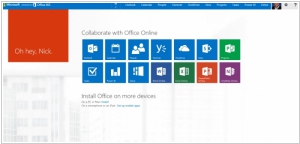LibreOffice vs Microsoft 365
March 20, 2025 | Author: Adam Levine
14★
LibreOffice is the power-packed free, libre and open source personal productivity suite for Windows, Macintosh and GNU/Linux, that gives you six feature-rich applications for all your document production and data processing needs: Writer, Calc, Impress, Draw, Math and Base. Support and documentation is free from our large, dedicated community of users, contributors and developers. The online and mobile version (for Android and iPad) are coming soon
27★
Microsoft 365 (formerly Microsoft Office 365) is commercial software plus services offering a set of products from Microsoft. Designed to help you achieve more with innovative Office apps, intelligent cloud services, and world-class security. The free online MS Office document editors (Word, Excel, PowerPoint) are available in OneDrive.
See also:
Top 10 Office suites
Top 10 Office suites
There are, at a glance, two major office suites in the universe and both of them believe they are the superior lifeform in the world of word processing. LibreOffice and Microsoft 365 each allow humans to write long, tedious documents, fiddle with spreadsheets that may or may not balance and create presentations that will be ignored by colleagues. They both graciously permit users to open and save documents in the bafflingly infinite variations of DOCX, XLSX and PPTX, formats which, much like time, seem to stretch and morph unpredictably. They are also available across multiple platforms because the universe has yet to decide on just one way to do anything properly.
LibreOffice, much like a small and determined rodent, is entirely free and fiercely independent, maintained by an organization in Germany that believes in freedom, justice and open-source software. It emerged in 2010 as a rebellious offspring of OpenOffice, which itself was a distant cousin of something else, in the way that all great software has an untraceable lineage. It prefers ODF files, doesn’t really do cloud collaboration unless you strap something external to it with duct tape and is generally favored by those who believe software should be free, privacy should be respected and large corporations should be viewed with deep suspicion.
Microsoft 365, on the other hand, is the towering corporate monolith that appeared in 2011, originally named Office 365 before someone in marketing decided it needed rebranding, probably for tax reasons. It is entirely cloud-based, loves subscriptions with the passion of a caffeinated salesperson and seamlessly integrates with Teams, OneDrive and SharePoint—whether you like it or not. It is packed with AI-powered features that attempt to predict what you want before you know it yourself, often with hilarious results. It is used by businesses, enterprises and people who don’t have the time or patience to explain to their IT department why they want to install something else.
See also: Top 10 Office suites
LibreOffice, much like a small and determined rodent, is entirely free and fiercely independent, maintained by an organization in Germany that believes in freedom, justice and open-source software. It emerged in 2010 as a rebellious offspring of OpenOffice, which itself was a distant cousin of something else, in the way that all great software has an untraceable lineage. It prefers ODF files, doesn’t really do cloud collaboration unless you strap something external to it with duct tape and is generally favored by those who believe software should be free, privacy should be respected and large corporations should be viewed with deep suspicion.
Microsoft 365, on the other hand, is the towering corporate monolith that appeared in 2011, originally named Office 365 before someone in marketing decided it needed rebranding, probably for tax reasons. It is entirely cloud-based, loves subscriptions with the passion of a caffeinated salesperson and seamlessly integrates with Teams, OneDrive and SharePoint—whether you like it or not. It is packed with AI-powered features that attempt to predict what you want before you know it yourself, often with hilarious results. It is used by businesses, enterprises and people who don’t have the time or patience to explain to their IT department why they want to install something else.
See also: Top 10 Office suites





